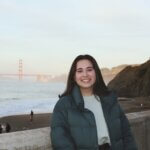Statement of Purpose: Ten Strands continues to introduce its staff through statements of purpose that reveal the motivations and ambitions of their work. Today, we hear from Julie Ira, Ten Strands’ climate corps fellow, who aims to inspire others, especially youth, to recognize and cherish their local environments through environmental education.
Growing up in San Francisco, I was incredibly fortunate to have a childhood experience immersed in nature. My home was located between three parks—six blocks to the west lay one park, while the other mirrored to the east. The expansive Golden Gate Park was only a few steps across the intersection from my home. Aside from these urban oases, my parents worked hard to provide my siblings and me with an abundance of adventures to explore the natural world across the state and nationally.

From leisurely afternoons in the park to family trips to destinations like Crater Lake and Yellowstone National Park, my formative years were punctuated by moments of awe and wonder. My parents instilled in me a deep appreciation for the beauty that surrounds us, whether it be found in the grandeur of iconic landscapes or in the smallest details of everyday life. Their teachings cultivated in me a reverence for the natural world and a keen eye for discovering beauty in the most unexpected places.
As we grew older, we got busier. Camping trips became less and less frequent. Weekends were booked with the bustling schedules of three active kids. My senior year of high school marked my first formal foray into environmental education and climate literacy. In AP Environmental Studies (APES), we delved into the complexities of climate change and the environment. However, with the demands of daily life, I could feel that my personal relationship with my local ecosystem was fragmented. It was hard for me to pause and connect with my own city environment. My perception of “nature” became limited to forests or large, isolated areas away from any signs of civilization.

Despite this shift in perception, the knowledge I received from my APES class drove me to pursue environmentalism in college. Choosing to major in environmental studies at the University of Washington proved to be a pivotal decision. Environmental education and climate literacy were the forces I needed to rebuild my personal bond with nature. Immersive learning experiences took me beyond the confines of traditional classrooms, with some of my classes being held outdoors in local parks and with field trips ranging from Friday Harbor to Mount Rainier National Park. Lessons on ecology, storytelling, and even dinosaurs sparked my curiosity and made me feel like a kid again. As feelings of awe and wonder returned, so did my passion for environmental stewardship, inspiring a deep commitment to safeguarding our planet for future generations.
Returning to San Francisco, I’m experiencing the city through a new lens. My personal relationship with the local environment has evolved into an investigation into the pockets of ecosystems that coexist with urban life. From the small flowers poking through the cracks of the concrete sidewalk, to the occasional coyote roaming during the early hours of the morning, I remind myself to view the environment with a sense of childlike wonder and excitement.

As I navigate through the early stages of my climate career, one thing remains abundantly clear: there is a significant opportunity to engage all people, starting at a young age, to demonstrate what nature looks like in their communities. It’s essential to show that the natural world is not limited to majestic and isolated areas. I am inspired to ensure that all students have the opportunity to realize and connect with their local environment. I firmly believe that environmental education holds the key to empowering students to become informed and proactive humans who are equipped to survive and address the pressing environmental challenges of today and tomorrow.

